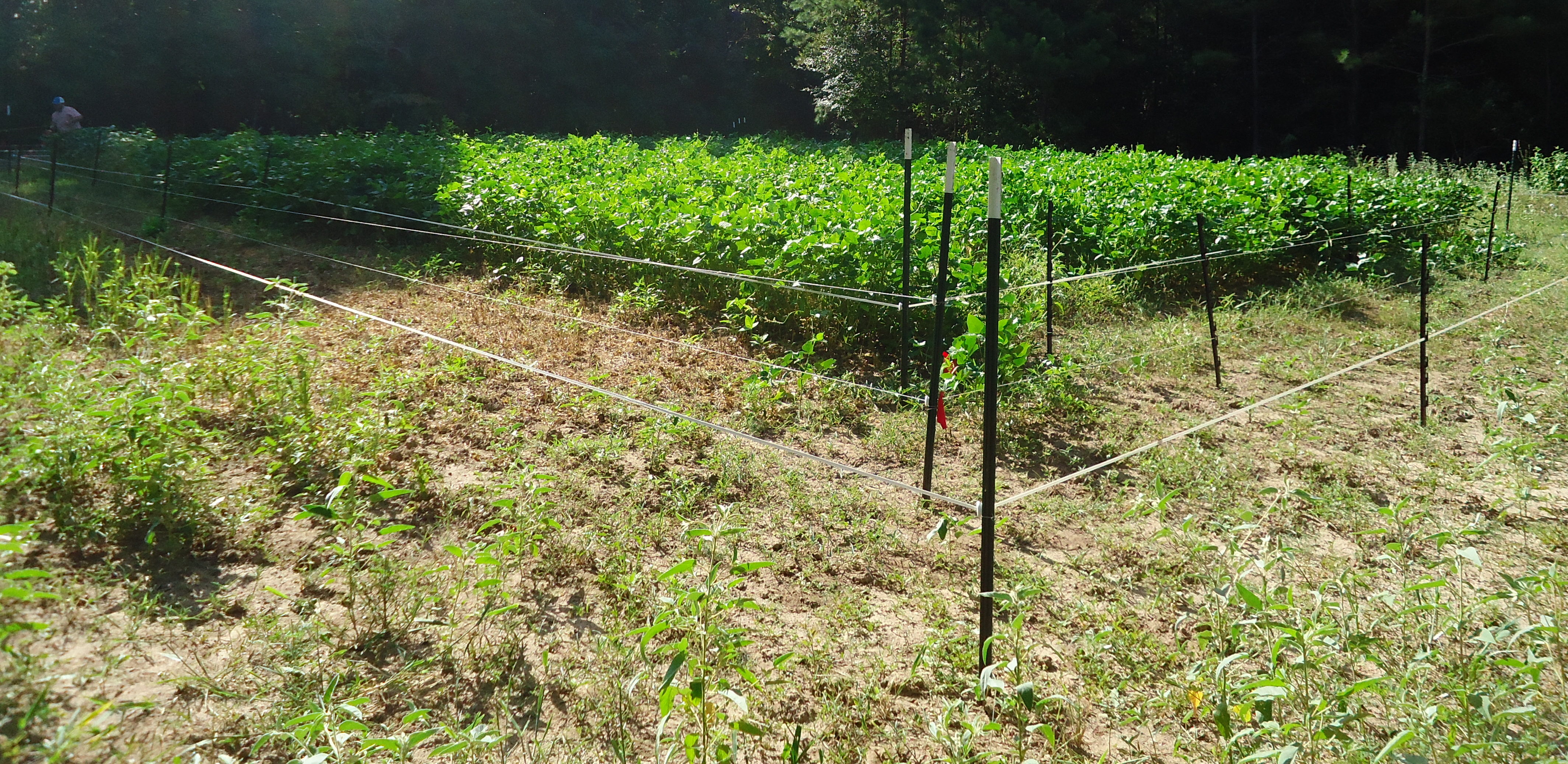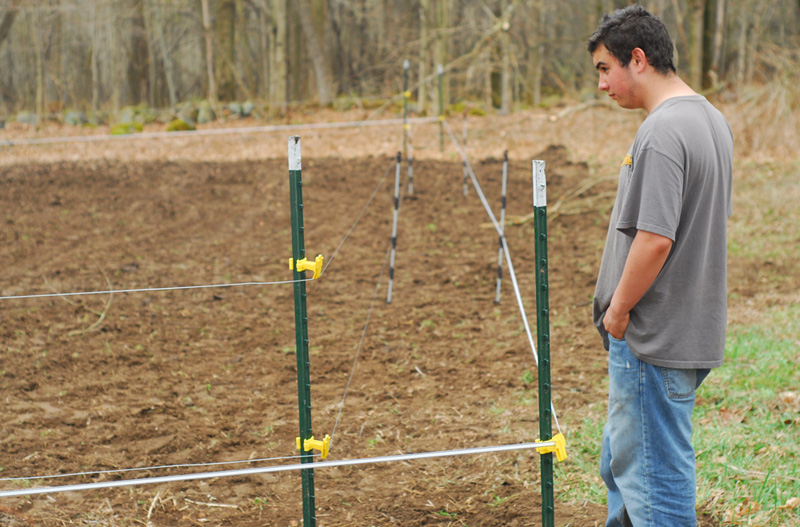Deer food plot electric fence – Electric fencing for deer food plots has become an essential tool for protecting crops from hungry deer. In this comprehensive guide, we’ll dive into the world of electric fences, exploring their benefits, design considerations, installation, maintenance, and more. Get ready to learn everything you need to keep your deer food plots safe and secure.
From choosing the right fence to troubleshooting common problems, we’ve got you covered. So, let’s get started and protect your crops from those pesky deer!
Electric Fencing for Deer Food Plots
Electric fencing is a reliable and effective method for protecting deer food plots from damage caused by deer. It creates a physical and psychological barrier that deters deer from entering the plot. Unlike traditional fencing methods, electric fencing does not require extensive maintenance and is less likely to be damaged by deer.
Choosing the Right Electric Fence
When selecting an electric fence for a deer food plot, consider the following factors:
- Height:A fence height of at least 8 feet is recommended to deter deer from jumping over.
- Wire spacing:Use horizontal wires spaced 6-8 inches apart to prevent deer from crawling under the fence.
- Voltage:A voltage of 6,000-8,000 volts is sufficient to deter deer effectively.
- Material:Choose wires made of stainless steel or aluminum for durability and resistance to corrosion.
Design Considerations for Electric Fences


Electric fences for deer food plots are a practical and effective means of keeping deer out. When designing an electric fence, several key factors must be considered to ensure its effectiveness.
The optimal height of an electric fence for a deer food plot is typically between 8 and 10 feet. This height provides a sufficient barrier while minimizing the risk of injury to deer.
The spacing between the wires of an electric fence is also crucial. The wires should be spaced close enough together to prevent deer from crawling through, but not so close that they touch, which can cause the fence to short out.
The materials used to construct an electric fence are also important. The posts should be made of durable materials such as steel or wood, and the wire should be made of a conductive material such as copper or aluminum.
Proper grounding and energizing of the fence are essential for its effectiveness. The fence should be grounded using a ground rod, and the energizer should be strong enough to deliver a sufficient shock to deter deer.
Wire Spacing
The spacing between the wires of an electric fence should be carefully considered. The wires should be spaced close enough together to prevent deer from crawling through, but not so close that they touch, which can cause the fence to short out.
A spacing of 6 to 8 inches is generally recommended.
Energizing the Fence
The energizer is the heart of an electric fence. It is responsible for delivering the electrical shock that deters deer. The strength of the shock is measured in volts, and the ideal voltage for a deer fence is between 6,000 and 8,000 volts.
Installation and Maintenance of Electric Fences


Installing an electric fence around a deer food plot is a relatively simple process that can be completed in a few hours. Here are the steps:
- Determine the perimeter of the food plot and mark the location of the fence posts. The posts should be spaced 10-15 feet apart.
- Dig holes for the posts, making sure that they are deep enough to support the fence.
- Set the posts in the holes and backfill with soil, tamping down firmly to secure the posts.
- Run the electric wire around the perimeter of the food plot, attaching it to the posts with insulators.
- Connect the electric wire to a fence charger.
- Test the fence to make sure that it is working properly.
Once the fence is installed, it is important to maintain it regularly. This includes:* Inspecting the fence regularly for any damage.
- Repairing any damage to the fence as soon as possible.
- Keeping the vegetation around the fence trimmed.
- Checking the fence charger regularly to make sure that it is working properly.
If you are having problems with your electric fence, there are a few things you can check:* Make sure that the fence charger is working properly.
- Check the connections between the fence charger, the fence wire, and the ground rod.
- Inspect the fence wire for any breaks or damage.
- Check the insulators for any damage.
- Make sure that the vegetation around the fence is trimmed.
Vegetation Management for Electric Fences: Deer Food Plot Electric Fence
Vegetation management is crucial for maintaining the effectiveness of electric fences. Overgrown vegetation can create a short circuit, reducing the fence’s voltage and allowing deer to pass through. It can also provide cover for deer, making them less likely to approach the fence.
There are several methods for controlling vegetation around electric fences:
Mowing
Regular mowing is the most common method of vegetation control. It can be done manually with a lawnmower or weed eater, or mechanically with a tractor-mounted mower.
Herbicides
Herbicides can be used to control vegetation that is difficult to mow, such as woody plants or tall grasses. However, it is important to choose herbicides that are safe for use around electric fences.
Grazing
Grazing animals, such as sheep or goats, can be used to control vegetation around electric fences. This is a cost-effective and environmentally friendly method, but it is only practical if you have access to grazing animals.
Tips for Preventing Vegetation from Interfering with the Fence’s Effectiveness, Deer food plot electric fence
- Mow or trim vegetation around the fence regularly.
- Use herbicides to control vegetation that is difficult to mow.
- Graze animals around the fence to control vegetation.
- Inspect the fence regularly for any vegetation that may be interfering with its effectiveness.
- Repair any damage to the fence caused by vegetation.
Cost and Considerations for Electric Fences


Electric fences are a cost-effective way to protect deer food plots from damage. The cost of installing and maintaining an electric fence will vary depending on the size of the plot, the type of fence used, and the labor costs in your area.
The initial cost of installing an electric fence includes the cost of the fence materials, the cost of the energizer, and the cost of labor. The cost of fence materials will vary depending on the type of fence you choose.
Woven wire fences are more expensive than polywire fences, but they are also more durable. The cost of the energizer will vary depending on the size of the plot and the power output of the energizer. The cost of labor will vary depending on the availability of labor in your area.
The ongoing cost of maintaining an electric fence includes the cost of electricity, the cost of repairs, and the cost of vegetation management. The cost of electricity will vary depending on the size of the plot and the power output of the energizer.
The cost of repairs will vary depending on the type of fence and the frequency of damage. The cost of vegetation management will vary depending on the type of vegetation and the size of the plot.
Tips for Reducing the Cost of Electric Fencing
- Choose the right type of fence for your needs. Woven wire fences are more expensive than polywire fences, but they are also more durable. If you have a large plot or a lot of deer pressure, a woven wire fence may be a better choice.
- Shop around for the best prices on fence materials and energizers. There are a number of different companies that sell electric fence supplies, so it’s important to compare prices before you buy.
- Install the fence yourself. Installing an electric fence is not difficult, and it can save you a lot of money on labor costs.
- Maintain your fence regularly. A well-maintained fence will last longer and require fewer repairs.
Safety Considerations for Electric Fences
Electric fences are an effective way to keep deer out of food plots, but they can also be dangerous if not properly installed and maintained. It is important to be aware of the potential hazards of electric fences and to take steps to avoid them.
One of the most important safety considerations is to make sure that the fence is properly grounded. A good ground will help to prevent the fence from becoming energized if it is accidentally touched or if lightning strikes nearby. To ground the fence, simply drive a metal rod into the ground near the fence and connect it to the fence wire with a copper wire.
Another important safety consideration is to use proper signage and warning devices. Signs should be placed at regular intervals along the fence, warning people that the fence is electrified. Warning devices, such as flashing lights or sirens, can also be used to alert people to the presence of the fence.
Finally, it is important to take precautions to prevent accidents and injuries. Never touch an electric fence with your bare hands. If you must work on the fence, be sure to wear rubber gloves and boots. Also, be aware of the location of the fence when you are mowing or trimming grass.
If you accidentally hit the fence with a metal object, it could become energized.
The electric fence is a great way to keep deer out of your food plot, but it’s important to make sure that the fence is properly installed and maintained. If the fence is not properly installed, it can be ineffective and even dangerous.
It is also important to make sure that the fence is properly maintained, as any damage to the fence can allow deer to enter the food plot. To keep your deer food plot secure, a well-maintained electric fence is essential, especially against strawberry deer who can jump higher than the average deer.
An electric fence, when installed and maintained properly, can be a very effective way to keep deer out of your food plot and protect your investment.
By following these safety precautions, you can help to prevent accidents and injuries when using electric fences.
Alternative Fencing Options for Deer Food Plots


Deer food plots are a great way to attract deer to your property and provide them with a nutritious source of food. However, it is important to fence your food plot to keep deer from eating the crops before they are mature.
There are a variety of fencing options available, each with its own advantages and disadvantages.One option is woven wire fencing. Woven wire fencing is a strong and durable option that is difficult for deer to penetrate. It is also relatively easy to install and maintain.
Protecting your deer food plot from hungry critters is crucial, and an electric fence can be a game-changer. If you’re looking for financing options, consider deere credit union moline for competitive rates and tailored solutions. With their support, you can invest in a robust electric fence that will keep your deer food plot safe, ensuring a bountiful harvest for years to come.
However, woven wire fencing can be expensive, and it can be difficult to see through, which can make it difficult to monitor your food plot.Another option is barbed wire fencing. Barbed wire fencing is a less expensive option than woven wire fencing, and it is also more visible.
However, barbed wire fencing can be more dangerous to work with, and it can be more easily damaged by deer.A third option is to use natural barriers to keep deer out of your food plot. Natural barriers can include rivers, streams, or dense vegetation.
Natural barriers can be a cost-effective way to keep deer out of your food plot, but they may not be as effective as woven wire or barbed wire fencing.The best type of fencing for your deer food plot will depend on your specific needs and budget.
If you are looking for a strong and durable fence that is difficult for deer to penetrate, then woven wire fencing is a good option. If you are looking for a less expensive option that is more visible, then barbed wire fencing is a good choice.
If you are looking for a cost-effective way to keep deer out of your food plot, then natural barriers may be a good option.
Woven Wire Fencing
Woven wire fencing is a strong and durable option that is difficult for deer to penetrate. It is made of galvanized steel wire that is woven together to create a mesh. Woven wire fencing is typically 4-6 feet tall and is available in a variety of gauges.
The thicker the gauge, the stronger the fence will be.Woven wire fencing is a good choice for deer food plots because it is difficult for deer to jump over or crawl under. It is also strong enough to withstand the force of a deer running into it.
Woven wire fencing is relatively easy to install and maintain. However, it can be expensive, and it can be difficult to see through, which can make it difficult to monitor your food plot.
Barbed Wire Fencing
Barbed wire fencing is a less expensive option than woven wire fencing. It is made of galvanized steel wire that is twisted together and has sharp barbs on it. Barbed wire fencing is typically 4-6 feet tall and is available in a variety of gauges.
The thicker the gauge, the stronger the fence will be.Barbed wire fencing is a good choice for deer food plots because it is less expensive than woven wire fencing and it is more visible. However, barbed wire fencing can be more dangerous to work with, and it can be more easily damaged by deer.
Natural Barriers
Natural barriers can be a cost-effective way to keep deer out of your food plot. Natural barriers can include rivers, streams, or dense vegetation. Natural barriers can be effective at keeping deer out of your food plot, but they may not be as effective as woven wire or barbed wire fencing.One
advantage of using natural barriers is that they are typically less expensive than woven wire or barbed wire fencing. Another advantage of using natural barriers is that they can be more aesthetically pleasing than woven wire or barbed wire fencing.
However, natural barriers may not be as effective at keeping deer out of your food plot, and they may require more maintenance than woven wire or barbed wire fencing.
Electric Fence Regulations and Legal Considerations
Electric fences for deer food plots are subject to various regulations and legal considerations. It’s crucial to understand these requirements to ensure compliance and avoid potential legal issues.
Permits and Approvals
In some areas, permits or approvals may be required before installing an electric fence. These permits are typically obtained from local authorities, such as the county or municipality. The requirements vary depending on the location and the size of the fence.
It’s advisable to contact the relevant authorities to determine if a permit is necessary.
Compliance with Local and State Laws
Electric fences must comply with local and state laws. These laws may specify the height, voltage, and spacing of the fence. They may also regulate the use of warning signs and the maintenance of the fence. Failure to comply with these laws can result in fines or other penalties.
Tips for Ensuring Compliance
To ensure compliance with electric fence regulations and legal considerations, follow these tips:
- Check with local authorities for permit requirements.
- Install the fence according to local and state laws.
- Post warning signs as required by law.
- Maintain the fence regularly to ensure it is in good working order.
- Contact your insurance company to verify coverage for electric fences.
By adhering to these regulations and legal considerations, you can protect yourself from potential legal liabilities and ensure the safe and effective use of an electric fence for your deer food plot.
Last Word
Electric fencing is a powerful tool for protecting deer food plots, offering numerous benefits and effective protection against deer damage. By following the guidelines Artikeld in this guide, you can design, install, and maintain an electric fence that will keep your crops safe and thriving.
Remember, proper planning, maintenance, and safety precautions are key to a successful electric fence system.
Questions and Answers
What are the benefits of using an electric fence for a deer food plot?
Electric fences provide a safe and effective deterrent against deer, preventing them from entering the food plot and causing damage to crops.
How do I choose the right type of electric fence for my deer food plot?
Consider factors such as the size of the plot, the type of vegetation, and the severity of the deer pressure when selecting an electric fence.
How often should I inspect and maintain my electric fence?
Regular inspections and maintenance are crucial for ensuring the effectiveness of the fence. Inspect the fence weekly and make repairs as needed.
What are some alternative fencing options for deer food plots?
Woven wire fencing, barbed wire fencing, and natural barriers are alternative options to electric fencing, each with its own advantages and disadvantages.








